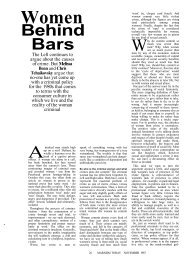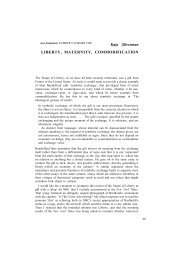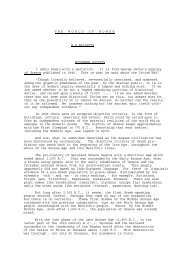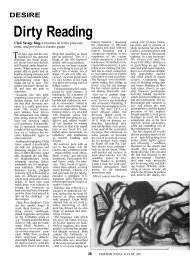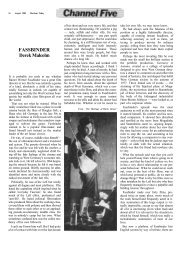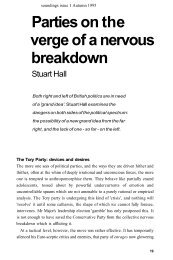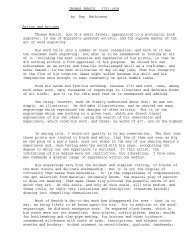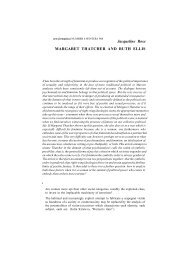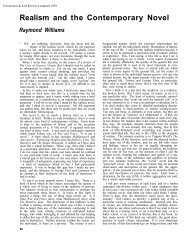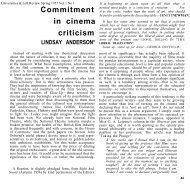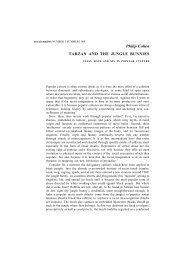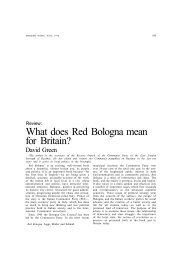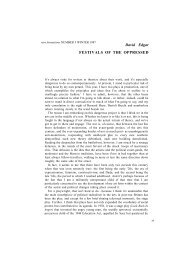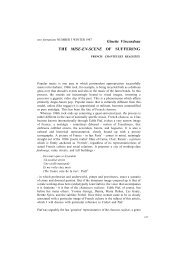The Notting Hill Carnival - Barry Amiel and Norman Melburn Trust
The Notting Hill Carnival - Barry Amiel and Norman Melburn Trust
The Notting Hill Carnival - Barry Amiel and Norman Melburn Trust
You also want an ePaper? Increase the reach of your titles
YUMPU automatically turns print PDFs into web optimized ePapers that Google loves.
Marxism Today August 1982 31<br />
Cecil Gutzmore<br />
<strong>The</strong> <strong>Notting</strong> <strong>Hill</strong> <strong>Carnival</strong><br />
On the final weekend of August 1982 some<br />
hundreds of thous<strong>and</strong>s of people will take<br />
part in the 16th annual <strong>Notting</strong> <strong>Hill</strong> <strong>Carnival</strong>.<br />
Before the urban <strong>and</strong> largely black<br />
uprisings of 1980 (St Pauls, Bristol) <strong>and</strong><br />
1981 (first in Brixton <strong>and</strong> then in at least 25<br />
other centres), the <strong>Carnival</strong> had been the<br />
setting for the major street disturbances in<br />
Britain since World War II. At the same<br />
time, the claim that it is one of Western<br />
Europe's premier cultural events proved difficult<br />
to dispute with attendances of up to<br />
half a million people in the mid-1970s.<br />
<strong>The</strong> connection between popular culture<br />
<strong>and</strong> challenges to constituted orders is by no<br />
means unique to the <strong>Notting</strong> <strong>Hill</strong> <strong>Carnival</strong>.<br />
Simply to say 'football hooliganism' is to<br />
indicate the truth of this in the United Kingdom<br />
context. It is not, though, to tell the<br />
whole story. <strong>Carnival</strong>s <strong>and</strong> festivals far <strong>and</strong><br />
wide have displayed this connection. <strong>The</strong><br />
observation of these by anthropologists in<br />
Africa has given us the notion of 'rituals of<br />
rebellion'. Similar observations exist for<br />
South America. Indeed, 'rituals of rebellion'<br />
have been detected as far back as the Ancient<br />
Orient where an instance is given from<br />
Babylon. <strong>The</strong>re they celebrated an annual<br />
religious festival called Sacees. This<br />
required the king to give a slave the chance<br />
to enact the role of king to the extent of. . .<br />
issuing orders <strong>and</strong> ab<strong>and</strong>oning himself to<br />
luxury <strong>and</strong> debauchery with the king's concubine.<br />
At the end of this the slave was<br />
hanged or crucified. In Sumer in a similar<br />
religious festival in 2050 BC the elevated<br />
slave-gardener usurped the throne, disposed<br />
of the king's son <strong>and</strong> reigned for twenty five<br />
years. <strong>The</strong> pattern recurs in Europe in modern<br />
times in the cities of Italy <strong>and</strong> Germany.<br />
It has led to the conclusion that:<br />
'<strong>Carnival</strong> is a cultural institution which regularises<br />
<strong>and</strong> ritualises the permanent social conflict.<br />
It is a ... form of class struggle. It enables<br />
the underprivileged class to make revolution<br />
without really performing it, <strong>and</strong> to improve its<br />
social position again <strong>and</strong> again for a short period<br />
of time without even touching the society's existing<br />
power structure'.'<br />
But this is not the whole story. Class<br />
struggle cannot always be ritualised. <strong>The</strong>re<br />
are situations in which the existing structures<br />
of power, class or wealth are unstable;<br />
are the object of quests for fundamental<br />
change. One such is the colonial situation.<br />
For example under British colonialism in<br />
Trinidad in the Caribbean the Carniva'<br />
broke the bounds of ritual. This was certainly<br />
so after slavery. <strong>The</strong> colonial order<br />
was too nervous to allow itself to be mocked.<br />
<strong>The</strong> danger that the masses (African <strong>and</strong><br />
later African <strong>and</strong> Asian) might shift from<br />
mock to real rebellion was perceived as 'a<br />
clear <strong>and</strong> present danger'. In the face of this<br />
fear suppression was attempted <strong>and</strong> this<br />
brought forth vigorous resistance from the<br />
people in defence of what they knew to be<br />
legitimate culture <strong>and</strong> against illegitimate<br />
(white, colonial) authority. 2 And within the<br />
United Kingdom itself, well before football<br />
became a main focus of working class cultural<br />
expression, well before the sway of the<br />
music hall, there were what have come to be<br />
called the metropolitan fairs.<br />
<strong>The</strong> growth of the <strong>Carnival</strong><br />
<strong>The</strong> <strong>Notting</strong> <strong>Hill</strong> <strong>Carnival</strong> is still with us.<br />
Alive, <strong>and</strong> on the streets of the Royal<br />
Borough of Kensington <strong>and</strong> Chelsea, London.<br />
It made its first appearance there in<br />
1966. It is largely agreed that its founding<br />
spirit was a white social worker, Mrs Laslette.<br />
<strong>The</strong> aim was to create a 'West Indian'<br />
carnival in this area of major black settlement<br />
in the UK. <strong>The</strong> model was the Eastern<br />
Caribbean <strong>and</strong> Trinidad in particular. But<br />
this was not the only model available. English<br />
people were not, after all, unfamiliar<br />
with the notion of 'carnival'. Even in terms<br />
of the local history of North Kensington<br />
there appears to have existed an idea of carnival<br />
as an 'olde' English celebration.<br />
Thus the main local newspaper of the<br />
period, the Kensington News <strong>and</strong> West London<br />
Times, contains references to 'carnivals'<br />
in the area before 1966. <strong>The</strong> model_was last<br />
dusted off <strong>and</strong> used as recently as the present<br />
Queen's silver jubilee. In any event elements<br />
of this 'English' idea of carnival were<br />
paraded at the first carnival in 1966.<br />
In the first eight years of its existence the<br />
<strong>Notting</strong> <strong>Hill</strong> carnival grew very slowly.<br />
Essentially it was small <strong>and</strong> run largely by<br />
people from the West Indies. <strong>The</strong> conflicts<br />
which appeared in those years were between<br />
West Indian individuals for control of the<br />
management of the event. Culturally its<br />
main contents were the music of the Trinidad<br />
originated steel b<strong>and</strong>, costume b<strong>and</strong>s<br />
from that same part of the world <strong>and</strong> African<br />
music from the b<strong>and</strong> of the late West African<br />
player Ginger Johnson. Black <strong>and</strong> white<br />
people attended. <strong>The</strong> Caribbean people<br />
1 Cultures Vol III no.l p 44, <strong>The</strong> Unesco Press<br />
(1976).<br />
2 Cultures Vol III nol pp 67-70.
32 August 1982 Marxism Today<br />
enjoyed the recreation of a little bit of'home'<br />
in the brutal slums of Northern Kensington:<br />
the whites, it may be presumed, enjoyed the<br />
exotica of it all. It seemed in every respect<br />
unchallenging to the state, both national <strong>and</strong><br />
local. <strong>The</strong> former, in the guise of its police<br />
force, made propag<strong>and</strong>a as its officers<br />
embraced booze, the odd 'spliff' (Indian<br />
hemp/weed) <strong>and</strong> black women. <strong>The</strong>y got<br />
themselves photographed doing some of<br />
these things <strong>and</strong> that was said by many to be<br />
good for race relations. <strong>The</strong> latter, the local<br />
state, was only worried about expense <strong>and</strong><br />
the feeling of its 'residents' <strong>and</strong> 'ratepayers'<br />
(all white for these purposes). Complaints<br />
were few.<br />
After <strong>Carnival</strong> 1973, certain important<br />
developments took place. A partly-owned<br />
agency of the local state called the North<br />
Kensington Amenity <strong>Trust</strong> had an ex-film<br />
director at its head. Underst<strong>and</strong>ing matters<br />
cultural, he took a benevolent interest in the<br />
<strong>Carnival</strong> intervening to secure or to help<br />
secure the directorship of the <strong>Carnival</strong> for an<br />
able <strong>and</strong> energetic young Trinidadian by the<br />
name of Lesley Palmer <strong>and</strong> to drum up good<br />
will for the event in the right quarters.<br />
<strong>Carnival</strong> 75<br />
In 1975 Palmer succeeded in organising the<br />
biggest <strong>Carnival</strong> ever in <strong>Notting</strong> <strong>Hill</strong>. He<br />
altered or broadened the cultural base of the<br />
event to include what was effectively the<br />
music of the black popular masses in the<br />
UK, namely the Jamaican originated reggae.<br />
It was brought via the agency of the best<br />
Sound Systems (black mobile discos of the<br />
sort treated in the film Babylon). Capital<br />
Radio, one of London's two commercial stations,<br />
attended <strong>and</strong> broadcast live from the<br />
event encouraging attendance. It is estimated<br />
that about half a million people came.<br />
Black attendance was on a country-wide<br />
basis. Suddenly the <strong>Carnival</strong> was the place<br />
to go to meet people one had not seen for
Marxism Today August 1982 33<br />
years. It was also an important commercial<br />
venue for the sale of Afro-Caribbean foods as<br />
well as drinks at prices from which frankly<br />
massive profits could be made. Also, <strong>and</strong> not<br />
unimportantly, a single car driven by a white<br />
man tried to speed through the crowd <strong>and</strong><br />
was wrecked at the centre of things at the<br />
junction of Portobello <strong>and</strong> Acklam Roads.<br />
Following <strong>Carnival</strong> 1975 things were<br />
never again the same. It may, in the words of<br />
the Deputy Council Leader — another Tory<br />
businessman —have '. . . proved to be a colourful<br />
<strong>and</strong> happy event enjoyed by a lot of<br />
people <strong>and</strong> a good influence for race relations<br />
in the area.' Nevertheless it had to go.<br />
<strong>The</strong> document just quoted was nothing less<br />
than his Memor<strong>and</strong>um of April 1976 to the<br />
Home Secretary in effect requesting a ban<br />
on the event. By then the <strong>Carnival</strong> was<br />
under wholesale attack from 'local residents',<br />
the local police comm<strong>and</strong>er <strong>and</strong> a<br />
local 'community action group', the Golborne<br />
100, led by the well known activist<br />
<strong>and</strong> theorist of 'community participation'<br />
George Clarke. <strong>The</strong> <strong>Carnival</strong> was said to<br />
have become 'the victim of its own success';<br />
to have become a 'field day for every wideboy<br />
<strong>and</strong> huckster'; to be disruptive of local<br />
community life. Incredible pressure was put<br />
on the carnival. <strong>The</strong> Royal Borough's position<br />
was that the event had to leave its streets<br />
for either the nearby open space called<br />
Wormwood Scrubs or go to the Chelsea football<br />
ground. Its proposals involving the latter<br />
space amounted to nothing less than a<br />
municipal take-over of fundamental aspects<br />
of the <strong>Carnival</strong>. <strong>The</strong> Borough said additionally,<br />
that should the event remain on the<br />
street <strong>and</strong> should funds not be forthcoming<br />
from the national exchequer, its own financial<br />
support would be limited to the provision<br />
of additional public toilets <strong>and</strong> cleaning<br />
up the streets after the event. <strong>The</strong> Metropolitan<br />
Police through its Divisional Comm<strong>and</strong>er<br />
Patterson supported the Borough's<br />
proposals. If they were not accepted the <strong>Carnival</strong><br />
would be ruthlessly policed right there<br />
on the streets. Each b<strong>and</strong> would be encircled<br />
by a 'serial' of 25 police officers: all previously<br />
permitted 'illegal' activity (from<br />
street selling to the vending of booze without<br />
a license, weed smoking etc) would be<br />
stamped out: the police would determine the<br />
routes of the <strong>Carnival</strong> procession <strong>and</strong> barricades<br />
would be used to prevent free flow<br />
within the terrain of the event which was to<br />
be 'sectored'. More comically, one 'white<br />
resident' observed that the West Indians<br />
already had a <strong>Carnival</strong> in Trinidad, what did<br />
they want another for?<br />
While there were those within the black<br />
community who were prepared to accept the<br />
proposals of the Royal Borough <strong>and</strong> the dicthat<br />
the masses might shift<br />
from mock to real rebellion<br />
was perceived as a real <strong>and</strong><br />
present danger<br />
tates of the police for reasons either of<br />
idiocy, backwardness or self-seeking, others<br />
resisted. Those who resisted pointed out to<br />
the authorities including, by letter, the then<br />
Police Commissioner Sir Robert Mark that<br />
attempted state repression of the <strong>Carnival</strong><br />
entailed an attack on a cultural form which<br />
had become important to the black community.<br />
<strong>The</strong>se warnings were, indeed, heard<br />
but the response of the Metropolitan Police<br />
was arrogantly to hold to its line <strong>and</strong> to<br />
prepare for a battle in which it contemplated<br />
neither defeat nor serious losses. An event<br />
which in 1975 had been policed with some<br />
80 officers saw the appearance in 1976 of<br />
hundreds of police persons on the streets.<br />
<strong>The</strong> Metropolitan Police staged a series of<br />
raids on all centres of entertainment on day<br />
one of the 1976 <strong>Notting</strong> <strong>Hill</strong> <strong>Carnival</strong> 'stallholders<br />
were arrested for obstructing the<br />
highway; the sellers of booze were arrested<br />
or reported. This, <strong>and</strong> more, made for an<br />
atmosphere of palpable oppression <strong>and</strong> not a<br />
'carnival' atmosphere. Not a carnival atmosphere<br />
certainly if that is taken to mean solely<br />
one of 'jollity' <strong>and</strong> yet in so far as it is also of<br />
the essence of carnivals as occasions of mass<br />
cultural expression that they are pregnant<br />
with rebellion, the police had succeeded in<br />
deepening the reality of this particular<br />
<strong>Carnival</strong>.<br />
A turning point<br />
Towards the end of day two of <strong>Carnival</strong><br />
1976 the resistance took on physical form.<br />
<strong>The</strong> police, who felt they had large enough<br />
forces to withst<strong>and</strong> anything, moved without<br />
restraint. <strong>The</strong>y claimed to be making<br />
arrests of pickpockets. In reality they were<br />
laying into black youths with their truncheons<br />
with a certain ab<strong>and</strong>on. <strong>The</strong> youths<br />
fought back. <strong>The</strong> battle spread to envelop<br />
large areas of the part of <strong>Notting</strong> <strong>Hill</strong> known<br />
locally as <strong>The</strong> Grove. Hundreds of youths<br />
joined battle against blatantly misused<br />
police power which is in reality part of the<br />
daily experience of the black community as a<br />
whole. It was on a terrain brimming over<br />
with missiles, with bricks, half bricks, bottles<br />
<strong>and</strong> canned soft drinks. More than 300<br />
of over 1600 officers deployed (officially)<br />
were injured. Pictures of these battles went<br />
round the world once more giving <strong>Notting</strong><br />
<strong>Hill</strong> the notoriety it had not experienced<br />
since 1958, the year of its historic race riots.<br />
<strong>The</strong> battle of the 1976 <strong>Notting</strong> <strong>Hill</strong> <strong>Carnival</strong><br />
gave world-wide confirmation to the fact<br />
that the culture of the black communities in<br />
the UK is inescapably one of resistance.<br />
<strong>The</strong> feeling that things have gone downhill<br />
all the way since 1976 for the <strong>Notting</strong><br />
<strong>Hill</strong> <strong>Carnival</strong> must be resisted. <strong>The</strong> event<br />
has remained under internal <strong>and</strong> external<br />
attack in the last six years. <strong>The</strong> central<br />
source of internal attack has been an externally<br />
fostered disunity. Whereas up to 1976<br />
there had never been any question of more<br />
than one organising committee for the<br />
event, afterwards a second was created with<br />
the active support of the Borough Council,<br />
the Commission for Racial Equality, Trinidad<br />
High Commission <strong>and</strong> West Indian<br />
St<strong>and</strong>ing Conference. <strong>The</strong>se agencies<br />
exploited the feelings of some 'carnival<br />
people' (steel <strong>and</strong> costume b<strong>and</strong> devotees)<br />
that the 'trouble' at the <strong>Carnival</strong> was caused<br />
by youth <strong>and</strong> reggae-based culture. <strong>The</strong><br />
solution they felt was to suppress this element<br />
—or at least ab<strong>and</strong>on it to its fate. <strong>The</strong><br />
police were a key external source of pressure.<br />
<strong>The</strong>y reached for the myth that their<br />
attitude in 1976 had been determined by the<br />
need to fight street crime within the <strong>Carnival</strong>.<br />
Mark had spoken of his opposition to<br />
'no go areas'. Later still in his autobiography<br />
he was to compare the black community's<br />
<strong>Carnival</strong> to the ancient crowds at Tyburn<br />
Field. But most importantly they mounted<br />
pressure for better protective gear for police<br />
officers. <strong>The</strong>y were issued with riot shields<br />
before <strong>Carnival</strong> 1977. And by 1978 they had<br />
learnt a whole series of lessons about crowd<br />
control, space control <strong>and</strong> street clearance<br />
operations which were applied with absolute<br />
ruthlessness in Southall in 1979 in defence<br />
of the National Front <strong>and</strong> against the Asian<br />
community. It was in this assault upon black<br />
people <strong>and</strong> the Left that Blair Peach was<br />
murdered. Blood red is one of the colours of<br />
<strong>Carnival</strong>.<br />
•



